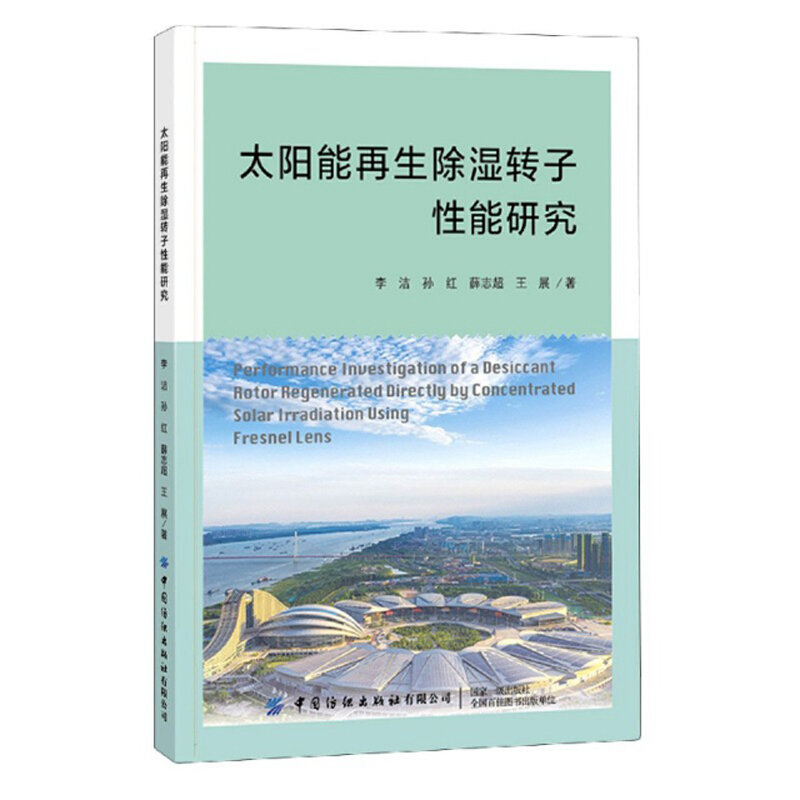
包邮太阳能再生除湿转子性能研究
¥21.1
(2.4折)
?
1星价
¥35.2
2星价¥35.2
定价¥88.0

温馨提示:5折以下图书主要为出版社尾货,大部分为全新(有塑封/无塑封),个别图书品相8-9成新、切口有划线标记、光盘等附件不全详细品相说明>>
暂无评论
图文详情
- ISBN:9787518071463
- 装帧:一般胶版纸
- 册数:暂无
- 重量:暂无
- 开本:16开
- 页数:103
- 出版时间:2020-10-01
- 条形码:9787518071463 ; 978-7-5180-7146-3
内容简介
太阳能除湿空调系统的耗电量比传统制冷系统大大减少,系统可由低品位能源,太阳能作为驱动力,减少了化石能源的消耗。同时系统以空气和水分为工质,对环境无害,干燥剂还可以有效吸附空气中的污染物质,提高了室内空气品质。本书中采用菲涅尔透镜聚焦太阳能直接辐射法再生除湿转轮。对除湿转轮内部进行传热传质分析,寻找降低再生能量损失提高系统除湿率的有效途径。通过宏观、介观和微观角度介绍了太阳能除湿转轮蜂窝通道内能量分布规律、多场耦合特性、基材水分传递规律和直接光致脱附水分子的动力特性等。本书针对太阳能除湿转轮再生过程中的能量损失、深入探索转轮吸附/脱附机理进行了详细介绍,为构建高性能太阳能除湿空调系统奠定理论和技术基础。
目录
Chapter 1 Introduction
1.1 Introduction
1.1.1 Background
1.1.2 Overview of desiccant cooling system
1.1.3 Advantages of desiccant cooling system
1.2 Solid desiccant cooling research
1.2.1 Basic structure and principle
1.2.2 Historical development and progress of solid desiccant cooling system
1.2.3 Energy source for desiccant rotor regeneration
1.3 Analysis methods for desiccant dehumidification
l.3 .l Theoretical studies
1.3.2 Experimental studies
References
Chapter 2 Measurements of energy distribution within narrow channels
2.1 Energy distribution measurement of laser irradiation
2.1.1 Concept of measurement
2.1.2 Data reduction
2.1.3 Materials
2.1.4 Apparatus
2.1.5 Conditions
2.1.6 Results and discussion
2.2 Energy distribution measurement of solar irradiation
2.2.1 Concept of measurement
2.2.2 Data reduction
2.2.3 Materials
2.2.4 Apparatus
2.2.5 Conditions
2.2.6 Results and discussion
2.3 Comparison between laser and solar irradiations
2.4 Conclusions
References
Chapter 3 Predictions for energy distribution
3.1 Concept of prediction models
3.1.1 Prediction model regarding the energy absorption efficiency
3.1.2 Prediction model of view factor
3.1.3 Prediction model of Beer' s law
3.2 Parameters for silica gel sample and accuracy evaluation
3.2.1 "RE2010" model
3.2.2 View factor model
3.2.3 Beer' s law model
3.3 Comparison of models
3.4 Conclusions
References
Chapter 4 Experiment for measuring water vapour adsorption/desorption rate in desiccant rotor
4, 1 Measurement system
4.1.1 Apparatus
4.1.2 Material
4.1.3 Conditions and data evaluation method
4.2 Measurements results and discussion
4.2.1 Temperature and humidity measurements
4.2.2 Influence of inlet air temperature, humidity and humidity ratio on the dehumidifying rate
4.2.3 Influence of air flow velocity
4.3 Conclusions
References
Chapter 5 Simulation of dehumidifying process of desiccant rotor
5.1 Mathematical analysis
5.1.1 Physical model
5.1.2 Governing equations
5.1.3 Calculation condition
5.1.4 Performance indices
5.2 Results and discussion
5.2.1 Comparison between experiment and simulation
5.2.2 Distributions of temperature, humidity, moisture removal and dehumidifying (adsorption) rate within desiccant rotor
5.2.3 Influence of amount of input solar energy and rotor thickness on total adsorption rate
5.2.4 Comparison between direct and indirect heating types
5.2.5 Influence of heat transfer coefficient between bed and air
5.2.6 Influence of air flow velocity ( contacting time)
5.3 Conclusions
References
展开全部
本类五星书
浏览历史
本类畅销
-

发电厂电气部分
¥34.6¥58.0 -

植物进化的故事
¥19.9¥59.0 -

赶往火星:红色星球定居计划
¥44.5¥58.0 -

数控车工
¥5.9¥11.5 -

低空无人机集群反制技术
¥82.6¥118.0 -

数据驱动的剩余寿命预测与维护决策技术
¥63.4¥79.0 -

手术机器人导航与控制
¥127.4¥169.8 -

射频干扰袖珍手册
¥18.4¥29.0 -

汽车车身构造与修复
¥30.7¥45.0 -

群目标分辨雷达初速测量技术
¥42.4¥69.0 -

秸秆挤压膨化技术及膨化腔流道仿真研究
¥40.6¥55.0 -

NVH前沿科技与工程应用
¥109.7¥159.0 -

电力系统分析
¥23.8¥38.0 -

继电保护原理
¥30.4¥49.0 -

不确定条件下装备剩余寿命预测方法及应用
¥60.4¥99.0 -

船舶分段装配
¥58.6¥80.0 -

基于深度学习的复杂退化系统剩余寿命智能预测技术
¥54.4¥89.0 -

火星探测器轨道动力学与控制
¥59.8¥98.0 -

美军联合作战弹药保障
¥35.8¥58.0 -

工程造价全过程管理系列丛书 工程结算与决算 第2版
¥37.4¥56.0











